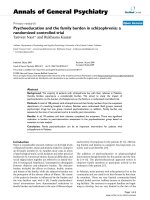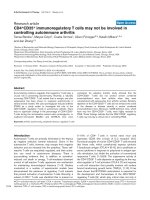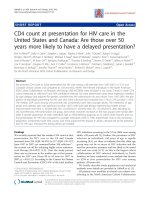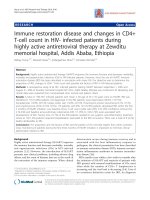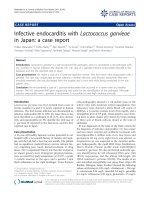Báo cáo y học: " CD4+ lymphocyte adenosine triphosphate determination in sepsis: a cohort study" pdf
Bạn đang xem bản rút gọn của tài liệu. Xem và tải ngay bản đầy đủ của tài liệu tại đây (513.4 KB, 6 trang )
Lawrence et al. Critical Care 2010, 14:R110
/>Open Access
RESEARCH
© 2010 Lawrence et al.; licensee BioMed Central Ltd. This is an open access article distributed under the terms of the Creative Commons
Attribution License ( which permits unrestricted use, distribution, and reproduction in
any medium, provided the original work is properly cited.
Research
CD4+ lymphocyte adenosine triphosphate
determination in sepsis: a cohort study
Kevin L Lawrence
1
, Patrick H White
1
, Gerald P Morris
2
, Jody Jennemann
3
, Donna L Phelan
3
, Richard S Hotchkiss
4
and
Marin H Kollef*
1
Abstract
Introduction: Patients suffering from sepsis are currently classified on a clinical basis (i.e., sepsis, severe sepsis, septic
shock); however, this clinical classification may not accurately reflect the overall immune status of an individual patient.
Our objective was to describe a cohort of patients with sepsis in terms of their measured immune status.
Methods: Fifty-two patients with sepsis (n = 13), severe sepsis (n = 21), or septic shock (n = 18) were studied. The
immune status was determined by measuring the CD4+ lymphocyte adenosine triphosphate (ATP) content after
mitogen stimulation in whole blood.
Results: The measured CD4+ lymphocyte ATP content at the time of ICU admission did not differ among the various
groups defined by the sepsis classification system (sepsis = 454 ± 79 ng/ml; severe sepsis = 359 ± 54 ng/ml; septic
shock = 371 ± 53 ng/ml; P = 0.44). Furthermore, survivors of sepsis had a significantly higher CD4+ lymphocyte ATP
content at the time of ICU admission than did nonsurvivors of sepsis (431 ± 41 ng/mL vs. 266 ± 53 ng/mL, respectively;
P = 0.04).
Conclusions: The sepsis classification system that is currently used is not representative of the individual immune
status as determined by measuring the CD4+ lymphocyte ATP content. Moreover, a lower CD4+ ATP content at the
time of ICU admission is associated with a worse clinical outcome in those suffering from sepsis.
Introduction
Sepsis, the systemic inflammatory response syndrome
that results from infection, is associated with consider-
able mortality. Besides controlling the inciting infectious
insult and providing good supportive care, few therapies
are available to treat this syndrome. Although it seems
conceptually appealing that suppressing the generalized
inflammatory response in sepsis would improve out-
comes, the evaluation of numerous adjuvant therapies
has led to conflicting, yet disappointing results [1-3].
Currently, patients suffering from sepsis are classified
based on the presence of organ dysfunction and/or shock
(i.e., sepsis, severe sepsis, septic shock). Although this
classification system is widely used, it may not accurately
reflect the overall immune status of an individual patient
(i.e., hypoimmune, hyperimmune) [4]. This is especially
important because the current sepsis treatment guide-
lines recommend consideration of the prescription of
immune altering therapy (i.e., corticosteroids) based on
the clinical classification of septic shock [5]. Furthermore,
corticosteroids alter cell-mediated immune function, and
evidence suggests that depressed cell-mediated immune
function is associated with worse clinical outcomes [6-9];
therefore, a biological marker of cell-mediated immune
status could have the potential to improve classification
and risk stratification in sepsis.
We hypothesized that the evaluation of a biomarker
used to determine the cell-mediated immune status
would be informative in a cohort of patients with sepsis.
Furthermore, we hypothesized that their measured
immune status might not be reflective of their sepsis clas-
sification. Finally, we hypothesized that their immune sta-
tus might be associated with mortality.
* Correspondence:
1
Department of Medicine, Washington University in St. Louis School of
Medicine, 660 South Euclid, Campus Box 8052, St. Louis, Missouri 63110, USA
Full list of author information is available at the end of the article
Lawrence et al. Critical Care 2010, 14:R110
/>Page 2 of 6
Materials and methods
Patient population and study setting
This study was approved by the Institutional Review
Board at Washington University School of Medicine
Human Studies Committee. Patients were enrolled in the
study within 24 hours of admission to the medical ICUs
at Barnes-Jewish Hospital in St. Louis, Missouri. In addi-
tion, patients met the criteria for sepsis (n = 13), severe
sepsis (n = 21), or septic shock (n = 18) as defined accord-
ing to the American College of Chest Physicians/Society
of Critical Care Medicine Consensus Conference [10]. All
patients, or an acceptable surrogate, provided informed
consent to participate in the study.
Patients deemed likely to have a poor outcome, for a
reason known at admission other than sepsis, severe sep-
sis, or septic shock (i.e., cardiac arrest or widely meta-
static cancer) were not enrolled in the study. Patients
were followed until hospital discharge, and their routine
clinical and laboratory data were recorded. All patients
received early goal-directed therapy according to a stan-
dard protocol emphasizing adequate volume administra-
tion, appropriate antibiotic administration, and optimal
oxygen delivery.
Specimen collection
Blood was collected into sodium heparin tubes (Vacu-
tainer; Becton Dickinson, Franklin Lakes, NJ, USA)
through existing venous catheters in all patients. This col-
lection was performed at serial time points during the
course of each patient's ICU stay. Specifically, blood was
collected at T
1
= ICU day 1 (admission), T
2
= ICU day 2 to
5, and T
3
= ICU day 8 (Figure 1). After collection, the
blood was then transported, at room temperature, to the
laboratory for same day processing. Blood specimens
were collected only during the course of the ICU stay.
CD4+ lymphocyte ATP content determination
The Immuknow
®
assay (Cylex Inc., Columbia, MD, USA)
was used to determine the ATP content of CD4+ lympho-
cytes and was performed according to the manufacturer's
instructions and previous descriptions [11,12]. Briefly,
100 μL of a 1:4 dilution of whole blood was incubated
with phytohemagglutinin (2.5 μg/mL) for 15 to 18 hours
in a 5% carbon dioxide incubator at 37°C. Anti-human
CD4 monoclonal antibody-coated magnetic particles
(Dynal, Oslo, Norway) were added to select CD4+ cells
after stimulation. After washing the selected CD4+ cells
selected on a strong magnet (Cylex Cat. 1050; Cylex Inc.,
Columbia, MD, USA), a lysing reagent was added to
release intracellular ATP. A luciferin/luciferase mixture
was then added to the cell lysate. Within 30 minutes after
the addition of enzyme, the bioluminescent product was
measured in a luminometer (PHL Mediators, Austria, or
Berthold, Maryville, TN, USA, or Turner Designs, Sunny-
vale, CA, USA). The amount of light emitted (emission
maximum 562 nm) was compared with a calibration
curve generated with ATP calibrators (0, 1, 10, 100, and
1,000 ng/mL). The concentration of ATP (ng/mL) in each
sample was then calculated from the calibration curve
using an Excel-based program provided by Cylex
(Columbia, MD, USA). Replicate samples with a calcu-
lated percentage coefficient of variation greater than 20%
were included in the calculation if a single value was
within three standard deviations of the mean value of all
wells.
Statistical analysis
All data are presented as the mean ± the standard error of
the mean unless otherwise indicated. All comparisons
were unpaired and all tests of significance were two-
tailed. SPSS version 11.0 for Windows (SPSS, Inc., Chi-
cago, IL, USA) was used for statistical analysis. Continu-
ous variables were compared using the Mann-Whitney U
test or the Kruskal-Wallis test, where appropriate, for
non-normally distributed variables. The Pearson chi-
squared was used to compare categorical variables. A P-
value of less than 0.05 was considered significant.
Role of the sponsor
The study sponsor, Cylex, Inc., had no role in the design
of the study. They also had no role in the collection or
interpretation of data, and they had no role in the prepa-
ration of the manuscript or the decision to submit it for
publication.
Results
Characteristics of the study population
We evaluated 52 patients in our investigation. Overall,
these patients appear representative of typical patients
with sepsis encountered in an ICU setting. Table 1 shows
Figure 1 Time frame of serial CD4+ lymphocyte ATP content and
patient flow during investigation.
Admitted to medical ICU and met inclusion and exclusion criteria N=52
CD4+ lymphocyte ATP determination within 24 hours of ICU admission (T
1
) N=52
Expired or discharged from ICU and/or hospital N=19
CD4+ lymphocyte ATP determination within ICU day 2-5 (T
2
) N=33
Expired or discharged from ICU and/or hospital N=18
CD4+ lymphocyte ATP determination on ICU day 8 (T
3
) N=15
Lawrence et al. Critical Care 2010, 14:R110
/>Page 3 of 6
the main characteristics of our study population. Thir-
teen patients were considered to be immunocompro-
mised based on one or more of the following criteria:
HIV positivity, organ transplant recipient, pharmacologic
immunosuppression, recent chemotherapy (within eight
weeks prior to enrollment).
Clinical and laboratory data according to conventional
sepsis classification
Figure 2 demonstrates the CD4+ lymphocyte ATP con-
tent according to the conventional sepsis classification at
the time of ICU admission. There was no significant dif-
ference in the CD4+ lymphocyte ATP content among
patients when grouped according to this classification
system (sepsis = 454 ± 79 ng/ml; severe sepsis = 359 ± 54
ng/ml; septic shock = 371 ± 53 ng/ml; P = 0.44). In addi-
tion, there was no significant difference in the total white
blood cell count among the different groups (sepsis = 16.4
± 3.4 × 10
3
cells/μL; 16.8 ± 2.0 × 10
3
cells/μL; 16.9 ± 2.5 ×
10
3
cells/μL; P = 0.82), and the absolute lymphocyte count
was also not significantly different among the groups (1.9
± 0.9 × 10
3
cells/μL; 1.0 ± 0.1 × 10
3
cells/μL; 2.3 ± 1.4 × 10
3
cells/μL, respectively; P = 0.98). Not surprisingly, the
Acute Physiology and Chronic Health Evaluation
(APACHE) II score did differ among the groups (16.4 ±
1.6; 23.7 ± 1.4; 25.1 ± 2.1, respectively; P = 0.006); how-
ever, the mortality difference among the groups did not
reach statistical significance (23.1%; 23.8%; 33.3%, respec-
tively; P = 0.75).
Clinical and laboratory data according to clinical immune
status
The mean CD4+ lymphocyte ATP content differed signif-
icantly between the immunocompetent group of patients
and the immunocompromised group of patients (437 ±
38 ng/mL vs. 237 ± 63 ng/mL, respectively; P = 0.01).
However, the total white blood cell count was not signifi-
cantly different between these groups(16.8 ± 1.4 ×
10
3
cells/μL vs. 16.6 ± 3.9 × 10
3
cells/μL, respectively; P =
0.65), and the absolute lymphocyte count was also not
significantly different (1.3 ± 0.3 × 10
3
cells/μL vs. 2.7 ± 1.9
× 10
3
cells/μL, respectively; P = 0.27). Furthermore, the
APACHE II score did not differ between the groups (22.2
± 1.3 vs. 22.9 ± 2.3, respectively; P = 1.00), and the mor-
tality also did not differ significantly (25.6% vs. 30.8%,
respectively; P = 0.73).
Figure 2 CD4+ lymphocyte ATP content at ICU admission among
patients when grouped according to the sepsis classification sys-
tem. P = 0.44. Black bars indicate the mean CD4+ lymphocyte ATP con-
tent for each group, respectively.
Table 1: Characteristics of study population (n = 52)
Characteristic Value
Age (years) 57 ± 2
Sex, n (%)
Male 27 (52)
Female 25 (48)
Race, n (%)
White 32 (62)
African American 20 (38)
Admitting sepsis classification, n (%)
Sepsis 13 (25)
Severe sepsis 21 (40)
Septic shock 18 (35)
Source of sepsis
Lung 27 (52)
Abdomen (including urinary source) 15 (29)
Blood 5 (10)
Other 5 (10)
Acute Physiology and Chronic Health Evaluation II
Score
22 ± 1
Source of admission
Emergency department 26 (50)
Hospital ward 18 (35)
Other 8 (15)
Length of stay (days)
ICU 5 ± 1
Hospital 13 ± 2
Culture results, n (%)
Positive 34 (65)
Negative 18 (35)
Immune status, n (%)
Immunocompetent 39 (75)
Immunocompromised 13 (25)
Lawrence et al. Critical Care 2010, 14:R110
/>Page 4 of 6
Clinical and laboratory data according to mortality
Table 2 demonstrates the mortality stratified by quartiles
of measured CD4+ lymphocyte ATP content. Clearly
there are differences in the mortality when patients are
stratified in this manner; however, these differences did
not reach statistical significance (P = 0.21). The total
white blood cell count was also not significantly different
between survivors and nonsurvivors (16.4 ± 1.4 vs. 17.5 ±
3.7 × 10
3
cells/μL, respectively; P = 0.87). In addition, the
absolute lymphocyte count was not significantly different
between the survivors and nonsurvivors (2.0 ± 0.7 vs. 0.8
± 0.2 × 10
3
cells/μL, respectively; P = 0.08). Not surpris-
ingly, the APACHE II score did differ between survivors
and nonsurvivors (19.8 ± 1.0 vs. 29.4 ± 2.3, respectively; P
< 0.0001).
Figure 3 demonstrates the serial measurements of
CD4+ lymphocyte ATP content over time during the ICU
stay grouped according to survivor and nonsurvivor sta-
tus. There was a significant difference in CD4+ lympho-
cyte ATP content at admission, T
1
, between survivors
and nonsurvivors (431 ± 41 ng/mL vs. 266 ± 53 ng/mL,
respectively; P = 0.04). Although differences were noted
in CD4+ lymphocyte ATP content at other time points,
statistical significance was not demonstrated other than
at admission (T
1
); however, fewer patients were evaluated
at subsequent time points.
Discussion
We have demonstrated that there is a wide range of CD4+
lymphocyte ATP content in a typical ICU population suf-
fering from sepsis. Furthermore, we have demonstrated
that the current sepsis classification (i.e., sepsis; severe
sepsis; septic shock) does not accurately reflect the CD4+
lymphocyte ATP content, and arguably, the immune sta-
tus of an individual patient. We have also demonstrated
that a lower CD4+ lymphocyte ATP content is associated
with a higher mortality, and most surprisingly, this find-
ing is present at the time of ICU admission.
Measuring CD4+ lymphocyte ATP content after expo-
sure to a stimulus is one method of determining the
global cell-mediated immune response, and this approach
has primarily been used as an aid to guide immunosup-
pressive therapy in transplant recipients [12,13]. In the-
ory, a biomarker such as this could yield valuable
information in staging the host immune response in the
setting of sepsis, and it could potentially identify those
who could benefit, or be harmed, by a particular inter-
vention [14]. For example, one might surmise that admin-
istering a therapy that lowers the immune status (i.e,
corticosteroids) based solely on the presence of shock
when in fact the immune status may already be markedly
suppressed could have an undesired effect because of
improper patient selection.
Our data are consistent with previously published
results suggesting that decreased cell-mediated immune
function is associated with a worse prognosis in the set-
ting of sepsis. For example, Heidecke and colleagues
demonstrated that decreased T cell proliferation corre-
lated with mortality in patients with post-operative sepsis
due to intraabdominal infections [8]. Furthermore,
Meakins and colleagues used reactivity to skin testing to
evaluate the host immune response and found decreased
reactivity to be associated with mortality in several
patient populations [9].
Interestingly, data are beginning to accumulate sup-
porting the notion that viruses may reactivate in immu-
nocompetent patients during times of critical illness, and
this reactivation seems to be associated with worse clini-
cal outcomes, including mortality [6,7]. In fact, it is con-
ceivable that these pathogens may represent an
epiphenomenon of an underlying 'acquired immunosup-
pressed state'; however, this is not to say that these patho-
gens may not be capable of causing end-organ disease
(i.e., true infections). To further support this notion, the
mean CD4+ lymphocyte ATP content from our sepsis
Figure 3 Serial measurements of CD4+ lymphocyte ATP content
during the course of ICU stay according to survival status. Data are
shown for T
1
= ICU day 1, T
2
= ICU day 2 to 5, and T
3
= ICU day 8. Num-
bers presented under the horizontal axis represent the number of pa-
tients in the survivor and nonsurvivor groups at the different time
points, respectively. * P < 0.05 for T
1
; P > 0.05 for T
2
and T
3
.
Table 2: Mortality by quartile of CD4+ lymphocyte ATP
content measure at the time of ICU admission
ATP content (ng/mL) Nonsurvivors/Total Mortality (%)
≤250 6/13 46
251-500 6/24 25
501-750 2/10 20
≥751 0/5 0
Statistical significance for mortality was P > 0.05 for comparisons
between quartiles.
Lawrence et al. Critical Care 2010, 14:R110
/>Page 5 of 6
nonsurvivors is similar to the reported mean CD4+ lym-
phocyte ATP content of solid-organ transplant recipients
(266 vs. 282, respectively) [12]. Similarly, the mean CD4+
lymphocyte ATP content from our sepsis survivors is
similar to the reported mean CD4+ lymphocyte ATP
content of healthy controls (431 vs. 432, respectively)
[12].
The reason for why lower CD4+ lymphocyte ATP con-
tent is associated with a worse prognosis is strictly specu-
lation, yet interesting. First, this decrease may be due to
mitochondrial dysfunction [15-19]. Second, this decrease
may be due to anergy of the lymphocytes to mitogen
stimulation [8,20]. It should also be noted that this
decrease may simply represent another form of organ
dysfunction lymphocyte bioenergetic failure in the
setting of sepsis.
Our study has several limitations that should be men-
tioned. First, the CD4+ lymphocyte counts were not
determined, so the measured CD4+ lymphocyte ATP
content could be an indirect measure of cell number.
However, previous experience using this assay in solid-
organ transplant recipients indicates that this is unlikely
to be the case, and we have reported the total lymphocyte
counts, which also support this notion. Also, our small
sample size limits our ability to draw definitive conclu-
sions regarding the use of this assay in staging the host
response to sepsis.
On the other hand, our study also has several strengths.
To our knowledge, this is the first investigation to use this
method in an attempt to stage the host immune response
in sepsis; therefore, our findings are important when
viewed as thought provoking and hypothesis generating.
Furthermore, patients in our study classified as immuno-
compromised based on clinical criteria had significantly
different assay results than those who were immunocom-
petent, which is similar to prior published data [12]. This
observed difference further supports the notion that this
assay is an objective marker of the global cell-mediated
immune status of an individual, and therefore, provides
useful information, particularly in the setting of sepsis.
In summary, we have demonstrated that the sepsis clas-
sification system that is currently used does not accu-
rately reflect the immune status of an individual when
measured by determining the CD4+ lymphocyte ATP
content. This finding raises the question, 'Is the current
sepsis classification system reliable at determining the
immune status, specifically cell-mediated immune status,
and should this classification system be used to direct
adjuvant immunomodulatory therapy in the setting of
sepsis?'. Furthermore, we have demonstrated that a lower
CD4+ ATP content is associated with a worse clinical
outcome in those suffering from sepsis, and importantly,
this finding is present at the time of ICU admission.
Conclusions
The sepsis classification system that is currently used is
not representative of the individual immune status as
determined by measuring the CD4+ lymphocyte ATP
content. Moreover, a lower CD4+ ATP content at the
time of ICU admission is associated with a worse clinical
outcome in those suffering from sepsis.
Key messages
• Sepsis is the systemic inflammatory response that
results from an infectious insult.
• Patients with sepsis are currently classified based on
the presence of organ dysfunction and/or shock (i.e.,
sepsis, severe sepsis, septic shock).
• The immune status of an individual patient may not
correlate with the current classification system that is
used to categorize these patients.
• Our data shows no significant difference in the mea-
sured immune status of patients based on the current
classification system.
• Patients with sepsis who have lower measures of
immune function at the time of ICU admission
appear to have an increased mortality.
Abbreviations
APACHE II: acute physiology and chronic health II.
Competing interests
This study was supported in part by Cylex Inc. through donations of laboratory
equipment and supplies. The study sponsor, Cylex, Inc., had no role in the
design of the study. They also had no role in the collection or interpretation of
data, and they had no role in the preparation of the manuscript or the decision
to submit it for publication.
Authors' contributions
KLL, PHW, GPM, JJ, DLP, RSH, and MHK all contributed to the conception and
design of the study or the acquisition of data or analysis and interpretation of
the data. All were involved in drafting the manuscript or revising it for intellec-
tual content. All gave final approval to the version of the manuscript to be pub-
lished.
Acknowledgements
This study was supported in part by the Mentors in Medicine program in the
Department of Medicine at Washington University School of Medicine in St.
Louis.
Author Details
1
Department of Medicine, Washington University in St. Louis School of
Medicine, 660 South Euclid, Campus Box 8052, St. Louis, Missouri 63110, USA,
2
Department of Pathology and Immunology, Washington University in St.
Louis School of Medicine, 660 South Euclid, Campus Box 8118, St. Louis,
Missouri 63110, USA,
3
HLA Laboratory, Barnes-Jewish Hospital, 1 Barnes-Jewish
Hospital Plaza St. Louis, Missouri 63110, USA and
4
Department of
Anesthesiology, Washington University in St. Louis School of Medicine, 660
South Euclid, Campus Box 8054, St. Louis, Missouri 63110, USA
References
1. Bone RC: Why sepsis trials fail. JAMA 1996, 276:565-566.
2. Freeman BD, Natanson C: Anti-inflammatory therapies in sepsis and
septic shock. Expert Opin Investig Drugs 2000, 9:1651-1663.
Received: 11 February 2010 Revised: 19 April 2010
Accepted: 11 June 2010 Published: 11 June 2010
This article is available from: 2010 Lawrence et al.; licensee BioMed Central Ltd. This is an open access article distributed under the terms of the Creative Commons A ttribution License ( which permits unrestricted use, distribution, and reproduction in any medium, provided the original work is properly cited.Critical Care 2010, 14:R110
Lawrence et al. Critical Care 2010, 14:R110
/>Page 6 of 6
3. Sprung CL, Annane D, Keh D, Moreno R, Singer M, Freivogel K, Weiss YG,
Benbenishty J, Kalenka A, Forst H, Laterre PF, Reinhart K, Cuthbertson BH,
Payen D, Briegel J, CORTICUS Study Group: Hydrocortisone therapy for
patients with septic shock. N Engl J Med 2008, 358:111-124.
4. Bone RC, Grodzin CJ, Balk RA: Sepsis: a new hypothesis for pathogenesis
of the disease process. Chest 1997, 112:235-243.
5. Dellinger RP, Levy MM, Carlet JM, Bion J, Parker MM, Jaeschke R, Reinhart
K, Angus DC, Brun-Buisson C, Beale R, Calandra T, Dhainaut JF, Gerlach H,
Harvey M, Marini JJ, Marshall J, Ranieri M, Ramsay G, Sevransky J,
Thompson BT, Townsend S, Vender JS, Zimmerman JL, Vincent JL,
International Surviving Sepsis Campaign Guidelines Committee,
American Association of Critical-Care Nurses, American College of Chest
Physicians, American College of Emergency Physicians, Canadian Critical
Care Society, European Society of Clinical Microbiology and Infectious
Diseases, European Society of Intensive Care Medicine, European
Respiratory Society, International Sepsis Forum, Japanese Association for
Acute Medicine, Japanese Society of Intensive Care Medicine, Society of
Critical Care Medicine, Society of Hospital Medicine, Surgical Infection
Society, World Federation of Societies of Intensive and Critical Care
Medicine: Surviving Sepsis Campaign: international guidelines for
management of severe sepsis and septic shock: 2008. Crit Care Med
2008, 36:296-327.
6. Limaye AP, Kirby KA, Rubenfeld GD, Leisenring WM, Bulger EM, Neff MJ,
Gibran NS, Huang ML, Santo Hayes TK, Corey L, Boeckh M:
Cytomegalovirus reactivation in critically ill immunocompetent
patients. JAMA 2008, 300:413-422.
7. Luyt CE, Combes A, Deback C, Aubriot-Lorton MH, Nieszkowska A,
Trouillet JL, Capron F, Agut H, Gibert C, Chastre J: Herpes simplex virus
lung infection in patients undergoing prolonged mechanical
ventilation. Am J Respir Crit Care Med 2007, 175:935-942.
8. Heidecke CD, Hensler T, Weighardt H, Zantl N, Wagner H, Siewert JR,
Holzmann B: Selective defects of T lymphocyte function in patients
with lethal intraabdominal infection. Am J Surg 1999, 178:288-292.
9. Meakins JL, Pietsch JB, Bubenick O, Kelly R, Rode H, Gordon J, MacLean LD:
Delayed hypersensitivity: indicator of acquired failure of host defenses
in sepsis and trauma. Ann Surg 1977, 186:241-250.
10. Anonymous: American College of Chest Physicians/Society of Critical
Care Medicine Consensus Conference: definitions for sepsis and organ
failure and guidelines for the use of innovative therapies in sepsis. Crit
Care Med 1992, 20:864-874.
11. ImmuKnow
®
: the Cylex
®
Immune Cell Function Assay [http://
www.cylex.net/pdf/ImmuKnow_Insert-cx.pdf]
12. Kowalski R, Post D, Schneider MC, Britz J, Thomas J, Deierhoi M,
Lobashevsky A, Redfield R, Schweitzer E, Heredia A, Reardon E, Davis C,
Bentlejewski C, Fung J, Shapiro R, Zeevi A: Immune cell function testing:
an adjunct to therapeutic drug monitoring in transplant patient
management. Clin Transplant 2003, 17:77-88.
13. Kowalski RJ, Post DR, Mannon RB, Sebastian A, Wright HI, Sigle G, Burdick J,
Elmagd KA, Zeevi A, Lopez-Cepero M, Daller JA, Gritsch HA, Reed EF,
Jonsson J, Hawkins D, Britz JA: Assessing relative risks of infection and
rejection: a meta-analysis using an immune function assay.
Transplantation 2006, 82:663-668.
14. Marshall JC, Reinhart K, International Sepsis Forum: Biomarkers of sepsis.
Crit Care Med 2009, 37:2290-2298.
15. Adrie C, Bachelet M, Vayssier-Taussat M, Russo-Marie F, Bouchaert I, Adib-
Conquy M, Cavaillon JM, Pinsky MR, Dhainaut JF, Polla BS: Mitochondrial
membrane potential and apoptosis peripheral blood monocytes in
severe human sepsis. Am J Respir Crit Care Med 2001, 164:389-395.
16. Brealey D, Brand M, Hargreaves I, Heales S, Land J, Smolenski R, Davies NA,
Cooper CE, Singer M: Association between mitochondrial dysfunction
and severity and outcome of septic shock. Lancet 2002, 360:219-223.
17. Crouser ED: Mitochondrial dysfunction in septic shock and multiple
organ dysfunction syndrome. Mitochondrion 2004, 4:729-741.
18. Fredriksson K, Hammarqvist F, Strigard K, Hultenby K, Ljungqvist O,
Wernerman J, Rooyackers O: Derangements in mitochondrial
metabolism in intercostal and leg muscle of critically ill patients with
sepsis-induced multiple organ failure. Am J Physiol Endocrinol Metab
2006, 291:E1044-1050.
19. Carre JE, Singer M: Cellular energetic metabolism in sepsis: the need for
a systems approach. Biochim Biophys Acta 2008, 1777:763-771.
20. Hotchkiss RS, Karl IE: The pathophysiology and treatment of sepsis. N
Engl J Med 2003, 348:138-150.
doi: 10.1186/cc9059
Cite this article as: Lawrence et al., CD4+ lymphocyte adenosine triphos-
phate determination in sepsis: a cohort study Critical Care 2010, 14:R110

![Báo cáo Y học: Effect of adenosine 5¢-[b,c-imido]triphosphate on myosin head domain movements Saturation transfer EPR measurements without low-power phase setting ppt](https://media.store123doc.com/images/document/14/rc/vd/medium_vdd1395606111.jpg)

